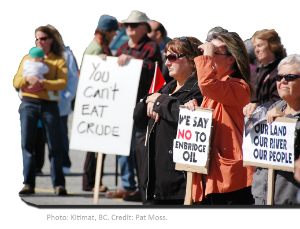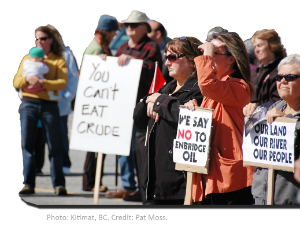
Environmental law organizations are increasingly talking about your right to a healthy environment. And that’s a good thing.
As environmental lawyers we know that as long as a company’s private property rights are considered a legal issue, but the public’s interest in a clean environment merely a political one, the environment – and the public - will lose in court. Recognizing that we all have a right to a healthy environment is pivotal. Doing so will mean taking environmental rights out of the esoteric realm of lawyers, and ensuring that environmental rights are something that is owned and claimed by Canadians.
The Twitter Moot and environmental rights
Our second Twitter Moot – an on-line contest for law students – focused on the legal basis for your right to a healthy atmosphere.  Because as long as politicians, fossil fuel companies and the public act like the global atmosphere is a dumping ground, then we’ll lose the fight against climate change. But if the global atmosphere is our heritage and our right, then we stand a chance.
Because as long as politicians, fossil fuel companies and the public act like the global atmosphere is a dumping ground, then we’ll lose the fight against climate change. But if the global atmosphere is our heritage and our right, then we stand a chance.
Congratulations to Samuel Harrison and Pippa Feinstein from the University of Alberta who won the Twitter Moot on November 20th. Sam and Pippa represented the Centre for Indigenous Environmental Resources, and argued in favour of the pubic right to a healthy atmosphere from an Indigenous perspective. Check out their cartoons used in their legal argument. They’ve announced (via Twitter) that they’ll be donating their $500 cash prize to our friends at the Environmental Law Centre of Alberta.
But while our Twitter Moot raised the profile of the idea of a public right to a healthy global atmosphere, legal argument, even over Twitter, is still the domain of the educated few. We believe that more Canadians need to claim their right to a healthy global atmosphere – not in a hypothetical legal appeal – but in their expectations related to action on climate change, and in their dealings with government, industry and their fellow citizens. We’d love to hear your ideas in the comments section below on how to achieve that.
Chemical Valley and environmental rights
Meanwhile, our friends at Ecojustice and the David Suzuki Foundation are also talking about the right to the environment. In addition to Ecojustice’s ground-breaking Chemical Valley’s case (which we’ve written about before), they have launched a public campaign calling for the protection of the right to a healthy environment. If you haven’t yet, you may want to sign their petition asking that the Canadian Charter of Rights and Freedoms be amended to explicitly protect environmental rights.
Ecojustice’s video, a Tale of 2 Valleys, is a must watch for those who want to understand why a right to a healthy environment matters. It tells the story of the Chemical Valley case – unfolding in Ontario – and the case of the Valley of Death, in Brazil, where a constitutional right to a healthy environment has transformed a toxic hell-hole and the lives of the people living there.
Another important resource is David Boyd's new book, the Environmental Rights Revolution, which looks at the impacts of national constitutions that protect the environment.
There is an existing legal basis for a constitutional right to a healthy environment
We would make just one qualification to the otherwise excellent material in the ecojustice video: there is actually an existing legal basis for a right to a healthy environmental in Canada - one that can be claimed and built upon by ordinary Canadians. According to the Supreme Court of Canada:
The notion that there are public rights in the environment that reside in the Crown has deep roots in the common law … Since the [mid-13th century] it has been the case that public rights and jurisdiction over these cannot be separated from the Crown. This notion of the Crown as holder of inalienable “public rights” in the environment and certain common resources was accompanied by the procedural right of the Attorney General to sue for their protection representing the Crown as parens patriae.
There are a variety of lower court judgments that adopt even clearer language. For example:
Interference with the rights of public health and safety, the right to untainted air and clean water and the right to fish in public waters have all been held to constitute public nuisance.
Furthermore, Ecojustice’s Chemical Valley case is based on the idea that the Canadian Charter of Rights and Freedoms protects Canadians from toxic pollution (although perhaps not as comprehensively as an explicit constitutional right to a healthy environment would). We, of course, agree with that idea.
The challenge is that it can be extraordinarily difficult for members of the public to assert these rights, and they certainly don’t have the legal protection we’d like. These are real barriers to using these environmental rights, and clearly the law needs to do better.
A broad movement
Just about every legal right protected in Canada’s Charter was claimed by a movement first, and championed outside the courts, until  not including it in the constitution became unthinkable.
not including it in the constitution became unthinkable.
In our view, protecting the environment through the law involves building broad movements of ordinary Canadians that assert that they have a collective right to a clean environment. That involves lawyers working with communities – as collaborators, not as privileged experts – to help translate their struggles into legal language.
We’d like to hear your ideas – how can environmental lawyers help make legal rights in respect of the environment more useful and relevant to activists, and to ordinary Canadians? How can Canadians assert their right to a clean environment – even when Canadian law may not yet have caught up to those demands? And how do we build a movement that is so committed to our public rights to a clean environment that Canadian governments will have to amend the Constitution to recognize those rights?
By Andrew Gage, Staff Lawyer
Thanks to our sponsors who made the Second-ever Twitter Moot possible. In addition to our sustaining sponsor, the Law Foundation of British Columbia, thanks to Ng Ariss Fong (who also sponsored Team #UofAlberta), Iler Campbell LLP, Lawyerlocate.ca, Saxe Law Office, and Willms Shier Environmental Lawyers LLP.